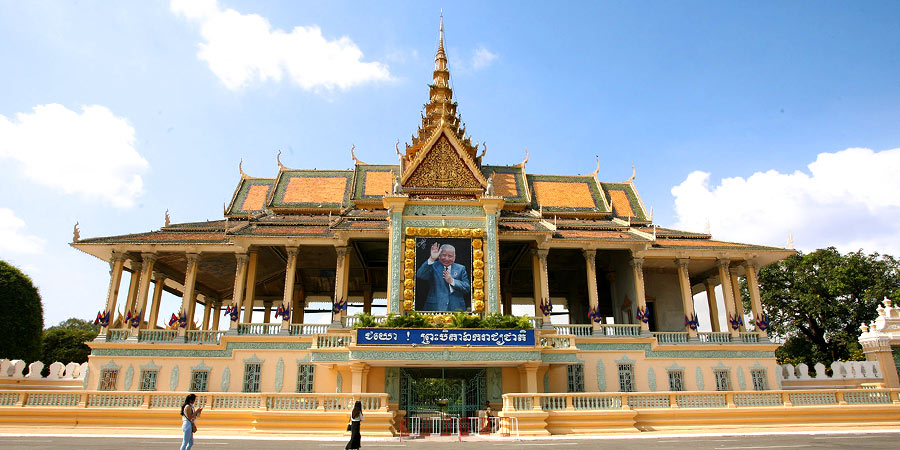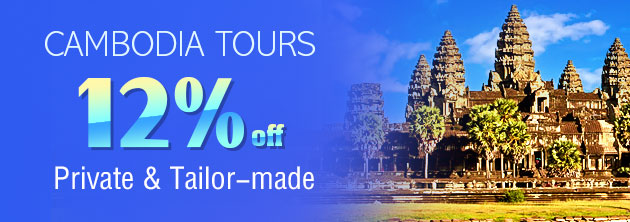The Royal Palace in Phnom Penh
Cambodia is one of the few countries in the modern-day world that still has a king. The country’s king resides in perhaps the country’s grandest architectural marvel, the Royal Palace in Phnom Penh. Thanks to its architectural magnificence, it has become one of the Cambodian capital’s most treasured tourist destinations.Over the course of this article, we will learn more about the Royal Palace in Phnom Penh, its history, its architectural highlights and what you need to do to visit this top tourist destination in Cambodia.

Royal Palace in Phnom Penh
|
History of the Cambodian Royal Palace
Cambodia is home to several architectural wonders that date back to the days of the ancient Angkor Empire. However, the Royal Palace in Phnom Penh is not one of them. In fact, compared to most other prominent feats of architecture in the country, Royal Palace can be considered new, as it was constructed only in the mid-19th century.The reason for the construction of this palace was simple. Back in 1865, then-King Norodom shifted the royal capital from the city of Oudong to Phnom Penh. Due to the king’s arrival, a new royal residence had to be built, and the Royal Palace was the result.
The renowned Khmer architect Neak Okhna Tepnimith Mak was hired by the king to design his new royal residential complex in 1866 and it’s fair to say that he did not disappoint the king. To bring the architecture’s grand ideas to life, the king spent heavily, with the resultant temple featuring the heavy use of numerous precious stones, gold, and marble.
The French Protectorate also had a huge role to play in the construction of Royal Palace in Phnom Penh, which is why the buildings inside the palace complex display a unique mixture of both ancient Khmer and 19th-century French architectural styles.
Iconic Buildings inside the Palace Complex
The Royal Palace in Phnom Penh is not a single building. The palace complex features a number of buildings. While some were built during the first construction of the complex, several others were added to the complex in the course of time. There are also sections that were there originally but were demolished eventually only to be reconstructed.Let’s take a look at some of the iconic buildings in Phnom Penh’s Royal Palace.
• The Throne Hall: While the Throne Hall was a part of the original construction, it experienced demolition, reconstruction and considerable expansion during the reign of King Sisowath, who ruled Cambodia in the early 20th century during 1904 – 1927.
Some of the architectural highlights of The Royal Palace’s Throne Hall are the 59-meter (193.6-feet) high central spire that features a four-faced Brahma at the top, three royal thrones and King Sisowath’s statue, which depicts him holding the Cambodian Royal Sword.
|
|
|
• Silver Pagoda: The Silver Pagoda, located on the palace complex’s southern side, is home to many national treasures that are considered important for preserving the country’s Buddhist heritages.
The main Silver Pagoda building houses numerous Buddha statues that are jeweled heavily. One of the most prominent among them is the “Emerald Buddha”, which conservators say was made from a rare crystal in either the 17th or the 19th century.
The highlight of the Silver Pagoda is the King Sisowath-commissioned life-size statue of Maitreya Buddha that features the use of over 9,000 diamonds.
During King Sihanouk’s reign prior to the dark days of the Khmer Rouge, the Silver Pagoda experienced renovations, with the king purchasing Italian marbles and 5,000 silver tiles to make the pagoda even more spectacular.
• Moonlight Pavilion: The Moonlight Pavilion is a pavilion that was and still is famous for hosting Khmer cultural events. The venue is most popular for showcasing classical Khmer dance performances.
The pavilion was a part of the Royal Palace in Phnom Penh during its initial days, it was later demolished and reconstructed under the rule of King Sisowath. The original pavilion featured wooden construction, but the modern avatar is drastically different in terms of construction and much bigger too.
The pavilion hosts royal and state banquets as well and it was used during the coronation of Norodom Sihamoni, the current king of Cambodia.
|
|
|
• Khemarin Palace: The Khemarin Palace building serves as the official residence of the Cambodian king and this is where King Norodom Sihamoni stays at present. The single spire at the top of the palace is what sets it apart from the other buildings inside the palace complex.
Apart from these four buildings, the Royal Palace in Phnom Penh has some other buildings that may be of interest to you such as the Hor Samran Phirun, Royal Stupas, Phochani Pavilion, and Napoleon III Pavilion.
Interesting Facts about the Royal Palace in Phnom Penh
• The areas that are open for both locals and tourists inside the Royal Palace in Phnom Penh are the central compound that contains The Throne Hall and the area around the compound of the Silver Pagoda. All other areas are strictly off-limits for visitors.• If you see a blue royal flag flying above the Khemarin Palace then you should know that the king is home.
• The palace’s western gate is often remembered as the ‘executing gate’ during the rule of previous kings, prisoners about to be executed were brought out of the palace through this gate.
• The Throne Hall features the primary use of two colors – white to symbolize Hinduism, the predominant religion during the days of the Angkor Empire, and yellow to symbolize Buddhism, the predominant religion at present.

Exhibits in Royal Palace
|
How to Reach the Royal Palace
The Royal Palace is just over 11 km (6.8 miles) from the Phnom Penh International Airport. It would take travelers approximately half an hour to complete the journey. You can avail private taxis and tuk-tuks which charge around $6 and $7 respectively for the journey from the airport to the Royal Palace. If you are booking a tuk-tuk, negotiate the price before you start the journey, as drivers tend to rip tourists off, especially during the peak tourist season.
More Popular Attractions in Phnom Penh:
Tuol Sleng Genocide Museum Phsar Thmei Market The Killing Fields of the Choeung Ek Wat Ounalom Russian Market Sisowath Quay

